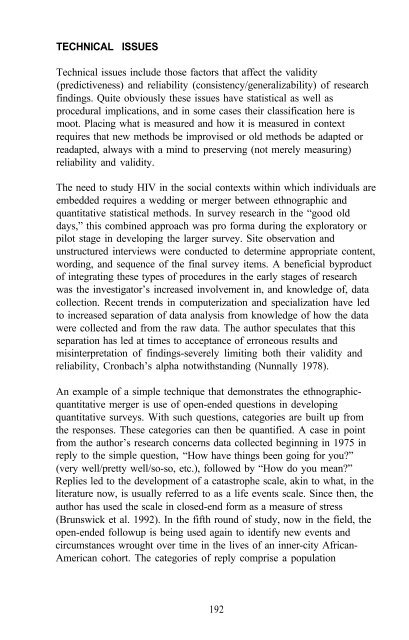The Context of HIV Risk Among Drug Users and Their Sexual Partners
The Context of HIV Risk Among Drug Users and Their Sexual Partners
The Context of HIV Risk Among Drug Users and Their Sexual Partners
Create successful ePaper yourself
Turn your PDF publications into a flip-book with our unique Google optimized e-Paper software.
TECHNICAL ISSUES<br />
Technical issues include those factors that affect the validity<br />
(predictiveness) <strong>and</strong> reliability (consistency/generalizability) <strong>of</strong> research<br />
findings. Quite obviously these issues have statistical as well as<br />
procedural implications, <strong>and</strong> in some cases their classification here is<br />
moot. Placing what is measured <strong>and</strong> how it is measured in context<br />
requires that new methods be improvised or old methods be adapted or<br />
readapted, always with a mind to preserving (not merely measuring)<br />
reliability <strong>and</strong> validity.<br />
<strong>The</strong> need to study <strong>HIV</strong> in the social contexts within which individuals are<br />
embedded requires a wedding or merger between ethnographic <strong>and</strong><br />
quantitative statistical methods. In survey research in the “good old<br />
days,” this combined approach was pro forma during the exploratory or<br />
pilot stage in developing the larger survey. Site observation <strong>and</strong><br />
unstructured interviews were conducted to determine appropriate content,<br />
wording, <strong>and</strong> sequence <strong>of</strong> the final survey items. A beneficial byproduct<br />
<strong>of</strong> integrating these types <strong>of</strong> procedures in the early stages <strong>of</strong> research<br />
was the investigator’s increased involvement in, <strong>and</strong> knowledge <strong>of</strong>, data<br />
collection. Recent trends in computerization <strong>and</strong> specialization have led<br />
to increased separation <strong>of</strong> data analysis from knowledge <strong>of</strong> how the data<br />
were collected <strong>and</strong> from the raw data. <strong>The</strong> author speculates that this<br />
separation has led at times to acceptance <strong>of</strong> erroneous results <strong>and</strong><br />
misinterpretation <strong>of</strong> findings-severely limiting both their validity <strong>and</strong><br />
reliability, Cronbach’s alpha notwithst<strong>and</strong>ing (Nunnally 1978).<br />
An example <strong>of</strong> a simple technique that demonstrates the ethnographicquantitative<br />
merger is use <strong>of</strong> open-ended questions in developing<br />
quantitative surveys. With such questions, categories are built up from<br />
the responses. <strong>The</strong>se categories can then be quantified. A case in point<br />
from the author’s research concerns data collected beginning in 1975 in<br />
reply to the simple question, “How have things been going for you?”<br />
(very well/pretty well/so-so, etc.), followed by “How do you mean?”<br />
Replies led to the development <strong>of</strong> a catastrophe scale, akin to what, in the<br />
literature now, is usually referred to as a life events scale. Since then, the<br />
author has used the scale in closed-end form as a measure <strong>of</strong> stress<br />
(Brunswick et al. 1992). In the fifth round <strong>of</strong> study, now in the field, the<br />
open-ended followup is being used again to identify new events <strong>and</strong><br />
circumstances wrought over time in the lives <strong>of</strong> an inner-city African-<br />
American cohort. <strong>The</strong> categories <strong>of</strong> reply comprise a population<br />
192
















